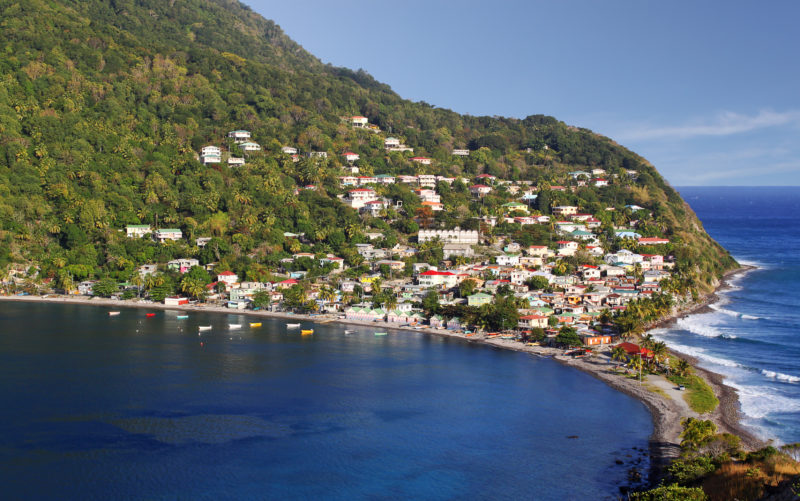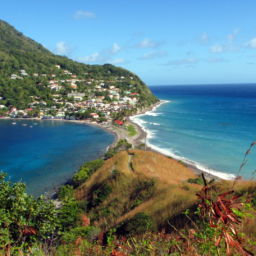***Among other islands, Dominica was hard hit by Hurricane Maria in September. If you’d like to help with recovery, please visit the Dominica Relief Fund.
Lonely Planet recently named the relatively unknown Caribbean island of Dominica (Dom-in-EEK-ah) one of the top 10 countries to visit in 2017. This strikingly beautiful island erupts straight out of the Caribbean Sea. Small settlements hug the coast, dwarfed by the steep volcanic mountains that form the island’s spine. Plump cumulous clouds perpetually brood over its lush peaks, blanketed with the most easily accessible primary rainforest in the Caribbean. As gorgeous as it is topside, the scuba diving in Dominica is just as remarkable.
Marketed as the “Nature Island,” Dominica delivers. Birders come seeking the endemic Sisserou parrot (Amazona imperialis) and other rare species. Adventurers trek up 4,747-foot (1,447 m) Morne Diablotins peak or hike eight miles (13 km) to Boiling Lake, the world’s second-largest hot spring. Film buffs paddle up the Indian River – one of 365 on the island – where scenes from Pirates of the Caribbean: Dead Man’s Chest were filmed. Others volunteer at the sea-turtle hatchery or go whale-watching off the western shore. Here, a 19,600-foot (6,000 m) trench offers food and safe passage for migrating sperm whales. But this is all prologue to some of the best scuba diving in the Caribbean.
World-class scuba diving
Dominica’s diving is some of the best in the Caribbean, with most dive sites along the western, leeward side of the island. In our experience, the sites dotted in and around Soufriere Bay in the south offer the most exciting diving on the island, with a variety and abundance of marine life that’s rare among other Caribbean dive destinations. The water is warm (81 to 85 F/28 to 29 C) and clear, with at least 50 feet (15 m) of visibility. The currents are few, and local dive staff are fun and knowledgeable.
A 3mm wetsuit is enough protection for most dives. Divers of any level are welcome, though an advanced open-water certification to 100 feet (30 m) comes in handy for the pinnacles and some wall dives. With that said, here’s a rundown of the best scuba diving in Dominica.
Champagne Reef
Probably the most well-known of Dominica’s dive sites is Champagne Reef, a few miles south of Roseau. Divers and snorkelers alike can bathe in the briny champagne of warm bubbles where volcanic gasses vent through small fissures in the hard-rock coral.
One of the few shore dives on the island, the entry is from a shoreline of stones the size of baseballs. By a depth of 10 feet (3 m), the stones have grown to algae-covered basketballs, interspersed with black-and-white urchins. There’s a remarkable variety of life, especially considering the elevated water temperature in the shallows. Porcupinefish, bold and uncharacteristically fearless, waddle among the abundant branches of yellow tube sponges. Soapfish play dead in the rubble. Arrow crabs brandish their blue-tipped claws.
Eventually the reef slopes down to around 33 feet (10 m). Here, the piles of boulders turn into a shallow wall. It’s easy to stay well above 60 feet (18 m), watching a trunkfish banging against hard coral, snacking on tiny invertebrates. A juvenile spotted drum performs its characteristic ribbon dance. One barrel sponge, a common feature of Dominican dive sites, hosts a huge channel-clinging crab. As the wall completes a long, slow curve to the left, soldierfish stand guard, moray eels jut out from crevasses, and assorted crabs skitter and hide.
At last the wall once again gives way to the boulders of the shallows, where the water warms noticeably as bubble streams flow to the surface. A fireworm braves the heat to crawl across a bubbling rock. In some areas, the water, blurred by thermocline, is hot to the touch.
Scott’s Head Drop Off
 Scott’s Head Drop Off sits in Soufriere Bay, in the southwest corner of the island. The bay is an underwater volcanic crater that offers dramatic underwater topography. The dive starts in the calm bay over a shallow, sandy area with coral bommies and areas of seagrass providing protection for nudibranchs and many small and juvenile fish. About 10 minutes into the dive, there is a drop off to a 130-foot (40 m) deep shelf. This, in turn, slopes down into the crater’s abyss.
Scott’s Head Drop Off sits in Soufriere Bay, in the southwest corner of the island. The bay is an underwater volcanic crater that offers dramatic underwater topography. The dive starts in the calm bay over a shallow, sandy area with coral bommies and areas of seagrass providing protection for nudibranchs and many small and juvenile fish. About 10 minutes into the dive, there is a drop off to a 130-foot (40 m) deep shelf. This, in turn, slopes down into the crater’s abyss.
Most divers stay relatively shallow, perhaps dipping down to 70 feet (23 m) to wave hello to a vermillion longlure frogfish. Along the way, divers may see anything from a large school of smallmouth grunts to a tiny wire coral shrimp. Out in the blue, a quick flash of silver may be a tunny or fast-moving barracuda. Up in the shallows, divers cans hunt for nudibranchs and other critters on their safety stop.
Swiss Cheese
If you like swim-throughs, you’ll love Swiss Cheese. The relatively shallow (52 feet/16 m), aptly named site features a number of swim-throughs. Many shelter schools of grunts or squirrelfish that give divers the side-eye as they pass through. The swim-throughs, a labyrinth of hills, valleys, a wall, and a bit of flat shelf combine to create an underwater obstacle course teeming with marine life. At safety-stop depth, lace coral, sea rods, gorgonians and sea fans form an underwater garden, with barrel sponges and brain coral offering some landscape architecture. Vivid reef fish swarm and flit like butterflies. A comedy routine breaks out: a surgeonfish appears to be chasing a triggerfish. A throng of brown chromis methodically dart in the light current, sucking in a feast of plankton. The dive is truly fun for everyone — divers and fish alike.
Dangleben’s Pinnacles
Dangleben’s Pinnacles sits on the northern edge of the Soufriere crater, which means it’s relatively exposed to the deep channel west of the island. Because of this, most dive shops won’t do this dive in current, as there is no place to hide. This is one of the deeper dive sites, with a minimum depth of 59 feet (18 m), but up to 98 feet (30 m) if you really want to explore.
And you will want to explore. It’s wonderful to follow experienced guides as they zigzag among the five pinnacles, freeing up divers’ attention to take in the sheer volume and variety of marine life. The truly gargantuan barrel sponges are among the biggest in Dominica. The sponges and corals explode in reds and yellows, purples and pinks, greens and blues. Sea creatures as large as a southern stingray and as miniscule as a pea crab share in the abundance. Juvenile angelfish, porcupinefish, a free-swimming sharp-tailed eel, an enormous giant basket starfish coiled up in a barrel sponge — this is one of the most vibrant reefs we’ve seen in the Caribbean.
Dangleben’s North
At first, Dangleben’s North seems like a rather mundane dive site. It starts over a barren sandy bottom with a few slivers of coral. Guides take the group west, away from the island, along a rocky channel lined with barrel sponges. At last, the channel opens to low hills of large-pored boulder and brain coral. This is where the excitement begins.
The reef teems with anthias, wrasses, butterflyfish and trumpetfish. A tiny painted frogfish hides in some pencil coral. A juvenile spotted drum wiggles and waves its ribbonlike fins. A long-snouted seahorse sways in some algae. A curious mutton snapper does a swim-by. A coney – neon yellow with blue freckles – attracts attention. The dive circles shallower over a sponge-encrusted reef. An orange, white, yellow and black clown crab has chosen a terrible place to hide: on a green finger sponge. A school of creole wrasse jumps and circles. The next thing you know, the 60-minute maximum dive time has flown by. Maximum depth on this busy dive site is around 52 feet (16 m), which makes it ideal for new divers as well as photographers.
Crater’s Edge
Situated at the southernmost point of the Soufriere crater, the calm Caribbean meets the raging Atlantic at this site, creating ample opportunities to spot pelagic creatures like rainbow runners and tuna. The confluence of the two bodies of water can create strong currents, so dive operators only attempt this legendary dive when conditions allow. Because of the depth at this dive site, with a maximum of 100 feet (30 m) and likelihood of at least some current, Crater’s Edge is best for experienced divers.
Orientation and getting there
A former British colony, Dominica is part of the Lesser Antilles archipelago in the southeastern Caribbean Sea. It sits between Martinique and Guadeloupe, about 1,400 miles (2,250 km) southeast of Miami. Its 71,000 citizens are sprinkled throughout the 290-square-mile (750-square-km) island. The highest population concentrations are along the west coast, particularly in the capital of Roseau and the town of Portsmouth.
Confusingly, the main airport is not Canefield Airport, near Roseau. Rather it’s the Douglas-Charles Airport, which is situated on the northeast corner of the island, about an hour’s drive from the capital. Because neither airport runway is long enough to accommodate long-range jets, there are no direct flights from the U.S. However, plans are in the works to extend the runway at Douglas-Charles. This should help the tourism authority achieve its goal of doubling the number of inbound tourists from the current rate of about 75,000 per year.
Guest author Christina Koukkos is a New York-based freelance writer and editor. She covers scuba diving, responsible tourism, off-beat destinations, cultural travel and other topics. She’s a certified PADI dive instructor and MSDT as well as an amateur underwater (and topside) photographer. Learn more about her on her website, her blog, on Instagram or Twitter.


